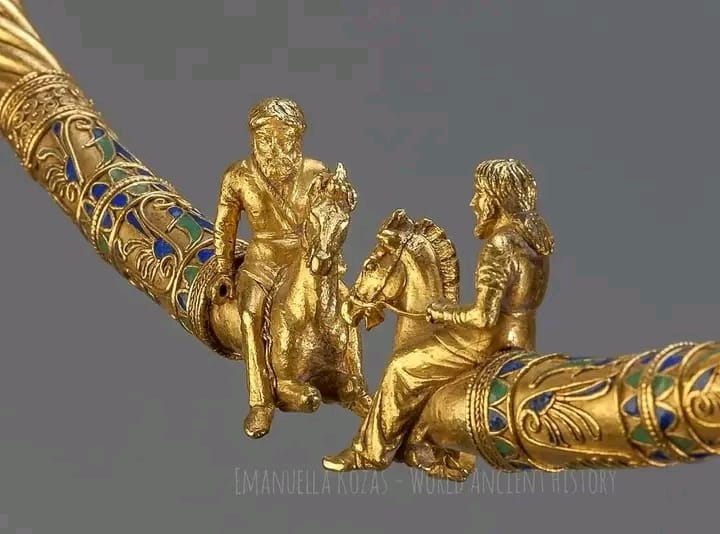The Gold Torque adorned with Scythian Riders, dating back to the 4th century BC, stands as an exceptional artifact unearthed from the ancient Hellenic Bosporan settlement of Panticapeon, situated in modern-day Crimea near the ancient city of Chersonesos. This extraordinary piece of jewelry not only showcases the masterful artistry of its time but also serves as a profound testament to the vibrant cultural exchanges between the Greeks and the local nomadic tribes.
Panticapeon, the city where this artifact was discovered, has a history that speaks volumes about the interconnectedness of ancient civilizations. Established by the Milesians during the late 7th or early 6th century BC, Panticapeon was strategically located along the Cimmerian Bosporus, a critical point for trade and cultural interactions. The settlement was built atop what is now known as Mount Mithridat, offering a commanding view of the surrounding area and cementing its importance as a hub of commerce and diplomacy.

During the 5th to 4th centuries BC, Panticapeon emerged as the royal residence for the Helleno-Thracian kings of Bosporus, often referred to simply as Bosporus. This period marked a time of unparalleled prosperity for the city. Its strategic location facilitated extensive trade between Greek settlers and the nomadic tribes of the region, fostering a unique blend of cultures. Economic activities thrived, particularly in agriculture and the grain trade, which were complemented by the production of luxury items, including artifacts like the Gold Torque. These economic endeavors played a pivotal role in establishing the city’s wealth and influence in the ancient world.
The Gold Torque itself epitomizes the craftsmanship and cultural significance of the period. Intricately adorned with depictions of Scythian riders, this artifact was far more than mere decoration. It symbolized status and power, likely belonging to an elite individual within ancient society. The detailed artistry of the torque highlights the exceptional skills of the craftspeople of that era, reflecting both Hellenic and local influences. This fusion of styles serves as a striking example of the cultural exchanges that were prevalent in Panticapeon and its surrounding regions.
However, the prosperity of Panticapeon was not without challenges. By the 4th to 3rd centuries BC, the city faced significant disruptions due to the Sarmatian conquests of the surrounding steppes. These conquests altered established trade routes, leading to economic decline. Compounding these difficulties was the competition posed by Egyptian grain production, which further diminished Panticapeon’s economic prominence. Despite these setbacks, the city’s role as a center of cultural exchange and political power has left an enduring legacy, making it a subject of continued interest for historians and archaeologists.
The discovery of the Gold Torque provides invaluable insights into the socio-political dynamics of the ancient world. Artifacts such as this illustrate how trade, cultural interactions, and military influences shaped the history of Panticapeon and the broader Bosporan Kingdom. The torque’s intricate design, featuring Scythian riders, underscores the deep connections between the Greek settlers and the nomadic tribes, revealing a shared narrative of identity and power. These connections are further evidenced by the blending of Hellenic and local traditions in the artifact’s craftsmanship, which speaks to the complexities of cultural identity during this period.
The significance of the Gold Torque extends beyond its aesthetic appeal. It serves as a tangible link to the past, offering a window into the intricate relationships and exchanges that defined the region during a time of significant historical change. This artifact exemplifies the ways in which material culture can shed light on the broader narratives of ancient societies, from trade and diplomacy to power dynamics and cultural identity.
As scholars continue to study the historical context of Panticapeon and its artifacts, the Gold Torque remains a focal point of research. Its discovery not only enriches our understanding of ancient craftsmanship but also underscores the importance of Panticapeon as a hub of cultural and economic activity. Through detailed analysis of such artifacts, researchers can piece together the stories of the people who lived, traded, and governed in this influential city.
The legacy of Panticapeon and its artifacts, such as the Gold Torque, provides a compelling glimpse into the ancient world. By examining the craftsmanship, cultural significance, and historical context of these treasures, we gain a deeper appreciation for the interconnectedness of ancient civilizations and the enduring impact of their exchanges. The Gold Torque, adorned with Scythian Riders, is more than just a remarkable piece of jewelry; it is a testament to the rich and complex history of a region that served as a crossroads of cultures and ideas.
In conclusion, the Gold Torque discovered in Panticapeon stands as an enduring symbol of the artistry and cultural exchanges that characterized the ancient world. This artifact not only showcases the exceptional craftsmanship of its time but also offers invaluable insights into the socio-political and cultural dynamics of the Bosporan Kingdom. As we continue to explore and study the treasures of Panticapeon, the Gold Torque remains a vital piece in the puzzle of understanding the broader narrative of ancient trade, culture, and power dynamics.





